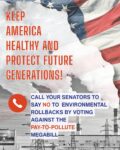- Share on Facebook
- Like
- Digg
- Tumblr
- VKontakte
- Buffer
- Love This
- Odnoklassniki
- Meneame
- Blogger
- Amazon
- Yahoo Mail
- Gmail
- AOL
- Newsvine
- HackerNews
- Evernote
- MySpace
- Mail.ru
- Viadeo
- Line
- Comments
- SMS
- Viber
- Telegram
- Subscribe
- Skype
- Facebook Messenger
- Kakao
- LiveJournal
- Yammer
- Edgar
- Fintel
- Mix
- Instapaper
- Copy Link
- Bluesky
by Vickie Wolfe
Here’s another quiz for you: Which of the following represents the greatest water pollution problem in the U.S.?
- discharges from power plants
- urban and agricultural runoff
- industrial discharges
- sewage
Correct answer: b. A common misconception is that industry, untreated sewage, etc. are the primary sources of water pollution in the U.S.
The federal Clean Water Act (CWA) prohibits “the discharge of any pollutant by any person” into “waters of the United States,” with the exception of those discharges that are in compliance with the CWA’s permit requirements and other provisions. In other words, industries, sewage treatment plants, power plants, etc. must obtain a permit before they discharge a drop of effluent into a body of water.
That permit specifies the allowable amounts of various pollutants that the effluent may contain. In setting those allowable amounts, the CWA’s goal is the achievement of a level of water quality which “provides for the protection and propagation of fish, shellfish and wildlife” and “for recreation in and on the water.” If the permit is violated, fines are imposed.
Is the CWA perfect? No. For one thing, dischargers may make an economic decision that it costs less to pay the fine for violating their permits than it does to install the technology necessary to purify the effluent enough to meet permit requirements. Fines for permit violations therefore need to be severe enough to encourage compliance.
Despite its imperfections, however, the CWA does a good enough job in the U.S. that “point sources” (i.e., discharges from the end of a pipe) are much less significant sources of water pollution than are nonpoint sources, such as runoff from agricultural fields, golf courses, lawns, pavement, etc., as well as pollution that falls out of the atmosphere (e.g. acid rain).
While nonpoint source pollution is a tough nut to crack, it also illustrates the principle that “everything is connected.” Virtually all acid rain results from the oxides of sulfur and nitrogen that are produced when fossil fuels are burned. Setting tougher limits for sulfur oxide (SOx) emissions is one answer, and in fact SOx emissions are now considerably lower than they were 2-3 decades ago; that does not, however, mean they are no longer a problem. Nitrogen oxides are harder to reduce because they are produced from the nitrogen naturally present in the atmosphere when combustion occurs at high temperatures like those in the engines of our cars. The bottom line is that our air and water pollution problems would decrease dramatically if we consumed less fossil fuels.
As for fertilizer and pesticide runoff, this is where organic agriculture comes in; certified organic farmers aren’t allowed to use chemicals. In a nutshell, organic farming methods are far healthier for the planet.
Finally, a number of books are available that explain how to have a nice lawn without chemicals. Two examples are Building a Healthy Lawn: a Safe and Natural Approach by Stuart Franklin, and Lawns by the publishers of Organic Gardening magazine.
Dr. Vickie Wolfe teaches biology at Marshall University and occasionally writes for the
WV Environmental Council, www.wvecouncil.org
Permission for use is granted only when the column is used in its complete
and unabridged, unedited form. Any changes void permission to use.







